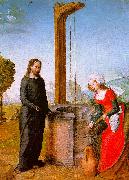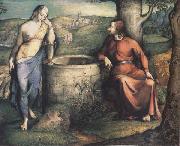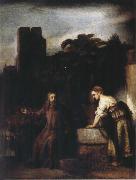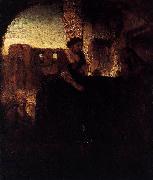Wholesale Oil Painting No Minimum |
|||||||||||
|
|
|||||||||||

|
|||||||||||
|
|
|
||||||||
Juan de FlandesFlemish-born Spanish Northern Renaissance Painter, ca.1460-1519 South Netherlandish painter, active in Spain. Nothing is known of his life or work before he went to Spain, where he is first mentioned in a document of 1496 as Juan de Flandes, a painter in the service of Queen Isabella of Castile. Treasury accounts confirm that he held this position until the Queen death in 1504. On arriving in Spain, he must have lived in Burgos, where he certainly met MICHEL SITTOW, another painter in the Queen service, who had been at the Castilian court since 1492. |
||||||||
|
|
||||||||
Christ and the Woman of Samaria
Christ and the Woman of Samaria Painting ID:: 1224 |
Musee du Louvre, Paris Musee du Louvre, Paris |
|||||||
|
|
||||||||
George RichmondEnglish Painter, 1809-1896 Painter, draughtsman and engraver. He was a precocious draughtsman. In 1824 he entered the Royal Academy, London, the same year as Edward Calvert, who was a part-time student of Joseph Severn. Richmond first exhibited at the Academy in 1825 and that year met William Blake in the Highgate house of John Linnell (ii). Like his lifelong friend Samuel Palmer, Richmond fell under Blake's spell, comparing him to the Prophet Isaiah and forming close friendships with Blake's other disciples, including Calvert. He visited Palmer at Shoreham, chiefly in the summer of 1827, and both he and Calvert became prominent members of Palmer's band of ANCIENTS, who frequented the Kent village in the late 1820s and early 1830s. The tempera panel Abel the Shepherd (1826; London, Tate) is typical of Richmond's early paintings, which reflect the pronounced influence of both Blake and Palmer. They are painted in an archaic style and include Christian and literary themes and high-minded if obscure genre subjects such as the Eve of Separation (1830; Oxford, Ashmolean). The human figure was central to these pictures as it was not for Palmer, who expressed sentiment through landscape motifs. Richmond was also active as a draughtsman and miniaturist during this period; his Christ-like head of Palmer, in watercolour and gouache on vellum (London, N.P.G.), dates from 1829. |
||||||||
|
|
||||||||
|
|
Christ and the Woman of Samaria
Christ and the Woman of Samaria Painting ID:: 26382 |
mk49
1828
Tempera on wood
41x49.8cm
mk49 1828 Tempera on wood 41x49.8cm |
||||||
|
|
||||||||
|
|
||||||||
|
|
Christ and the woman of samaria
Christ and the woman of samaria Painting ID:: 27565 |
mk56
oil on canvas
Follower of Lodewijck Toeput,called il Pozzoserrato
mk56 oil on canvas Follower of Lodewijck Toeput,called il Pozzoserrato |
||||||
|
|
||||||||
REMBRANDT Harmenszoon van RijnBorn 1606, Died 1669.One of the great Dutch painters and printmakers of the 17th century, Rembrandt van Rijn is best known for his expressive use of light and shadow (also called chiaroscuro) in his many portraits. Raised in Leiden, he studied with Pieter Lastman (1583-1633) in Amsterdam, then returned to Leiden around 1625 and set up shop as a teacher and portrait artist. Sometime between 1630 and 1632 Rembrandt relocated to Amsterdam, where he spent the rest of his career. Though he had his detractors (some of whom considered him coarse and "low born"), Rembrandt was successful and famous during his lifetime, though he fell on financial hard times in his later years. He was a master printer and produced hundreds of group portraits and historical paintings, including The Anatomy Lesson of Dr. Tulp (1632), The Military Company of Captain Frans Banning Cocq (1642) and Aristotle with a Bust of Homer (1653). His portraits -- including a lifelong trail of intriguing and rather frank self-portraits -- reveal his interest in psychological study and continue to be admired as landmarks in Western art. The Military Company of Captain Frans Banning Cocq is also known as "The Night Watch" because it was thought the painting depicted a nighttime scene. When the painting was cleaned in the 1940s it became obvious that it depicted a daytime scene... He married Saskia van Ulenburgh (also Uylenburgh) in 1634. |
||||||||
|
|
||||||||
|
|
Christ and the Woman of Samaria
Christ and the Woman of Samaria Painting ID:: 34523 |
mk93
1655
Oil on panel
25x19 1/4in
Metropolitan Museum of Art.
New York
mk93 1655 Oil on panel 25x19 1/4in Metropolitan Museum of Art. New York |
||||||
|
|
||||||||
Rembrandt van rijn1606-1669 Dutch painter, draughtsman and etcher. From 1632 onwards he signed his works with only the forename Rembrandt; in documents, however, he continued to sign Rembrandt van Rijn (occasionally van Rhyn), initially with the addition of the patronymic 'Harmensz.'. This was no doubt in imitation of the great Italians such as Leonardo, Michelangelo, Raphael and Titian, on whom he modelled himself, sometimes literally. He certainly equalled them in fame, and not only in his own country. His name still symbolizes a whole period of art history rightfully known as 'Holland's Golden Age'. In 1970-71 a great exhibition in Paris was devoted to it under the eloquent title Le Si?cle de Rembrandt. A century before, a popular work of cultural history by C. Busken Huet referred to the Netherlands as 'the land of Rembrandt'. His fame is partly due to his multi-faceted talent. Frans Hals was perhaps at times a greater virtuoso with the brush but remained 'only' a portrait painter. Vermeer may have excelled Rembrandt in the art of illusion but was less prolific. Rembrandt was not only a gifted painter but also an inspired graphic artist: he has probably never been surpassed as an etcher, and he often seems inimitable as a draughtsman. His subjects reflect his manifold talent and interests. He painted, drew and etched portraits, landscapes, figures and animals, but, above all, scenes of biblical and secular history and mythology. |
||||||||
|
|
||||||||
|
|
Christ and the Woman of Samaria
Christ and the Woman of Samaria Painting ID:: 80611 |
Date 1659(1659)
Medium Oil on oak
Dimensions Height: 48 cm (18.9 in). Width: 41 cm (16.1 in).
cjr Date 1659(1659) Medium Oil on oak Dimensions Height: 48 cm (18.9 in). Width: 41 cm (16.1 in). cjr |
||||||
|
|
||||||||
Rembrandt Peale1778-1860 Rembrandt Peale Galleries Rembrandt Peale (February 22, 1778 ?C October 3, 1860) was a 19th century American artist that received critical acclaim for his portraits of presidents George Washington and Thomas Jefferson. Although modern art critics would consider Peale??s artwork as French neoclassical, its dark and stylized characteristics are similar to 15th and 16th century paintings. Rembrandt Peale was born the third of six surviving children (eleven had died) to his mother, Rachel Brewer, and father, Charles Willson Peale in Bucks County, Pennsylvania, on February 22, 1778. The father, Charles, also a notable artist, taught each child to paint scenery and portraiture, and Rembrandt was no exception. Charles tutored Rembrandt about the importance of having a strong mind from learning arts and sciences. At the age of eight, Rembrandt discovered drawing, and at thirteen, painted his first known self-portrait. Later on in his life, Rembrandt Peale "often showed this painting to young beginners, to encourage them to go from 'bad' to better..." like his steady progressions to become a successful portraitist. A year after his mother??s death and remarriage of his father, Rembrandt Peale left the school of the arts, thereby applying his time to completing his first ever self-portrait at the age of 13. The canvas illustrates early mastery of a young aspiring artist, seeming very mature. The clothes, however give the notion that Peale over-exaggerated what a 13 year old would look like. This style demonstrates early forms of neoclassicism by the looks of Peale's angel-like hair, the way it waves and curls in such a fashion so as to depict an angel from a general Renaissance artist's works of art. In July of 1787, Charles Willson Peale introduced his son Rembrandt to George Washington, where the young aspirant artist watched his father paint the remarkable figure of the country. In 1795, at the age of 17, Rembrandt painted an aging Washington, though the painter had depicted the politician as far more aged than the original facial characteristics. It did, nevertheless attain praise and Rembrandt had begun his debut. At the age of 20, Rembrandt married 22-year-old Eleanor May Short (1776-1836) at St. Joseph's Catholic Church in Philadelphia. During their marriage, Rembrandt and Eleanor had nine children: Rosalba, Eleanor, Sarah Miriam, Michael Angelo, and Emma Clara among them. In 1822, Peale moved to New York City where he embarked on an attempt to paint what he hoped would become the "standard likeness" of Washington. He studied portraits by other artists including John Trumbull, Gilbert Stuart and his own father, as well as his own 1795 picture which had never truly satisfied him. His resulting work Patriae Pater, completed in 1824, depicts Washington through an oval window, and is considered by many to be second only to Gilbert Stuart's iconic Athenaeum painting of the first president. Peale subsequently attempted to capitalize on the success of what quickly became known as his "Porthole" picture. Patriae Pater was purchased by Congress in 1832 and still hangs in the U.S. Capitol. Later on, Peale made over 70 detailed replicas of the same "father of our country", the first President of the United States. Peale continued to paint other noted portraits, such as those of the third president Thomas Jefferson while he was in office (1805), and later on a portrait of Chief Justice John Marshall. |
||||||||
|
|
||||||||
|
|
Christ and the Woman of Samaria
Christ and the Woman of Samaria Painting ID:: 84810 |
1659(1659)
Medium Oil on oak
cyf 1659(1659) Medium Oil on oak cyf |
||||||
|
|
||||||||
|
Rembrandt Peale 1778-1860 Rembrandt Peale Galleries Rembrandt Peale (February 22, 1778 ?C October 3, 1860) was a 19th century American artist that received critical acclaim for his portraits of presidents George Washington and Thomas Jefferson. Although modern art critics would consider Peale??s artwork as French neoclassical, its dark and stylized characteristics are similar to 15th and 16th century paintings. Rembrandt Peale was born the third of six surviving children (eleven had died) to his mother, Rachel Brewer, and father, Charles Willson Peale in Bucks County, Pennsylvania, on February 22, 1778. The father, Charles, also a notable artist, taught each child to paint scenery and portraiture, and Rembrandt was no exception. Charles tutored Rembrandt about the importance of having a strong mind from learning arts and sciences. At the age of eight, Rembrandt discovered drawing, and at thirteen, painted his first known self-portrait. Later on in his life, Rembrandt Peale "often showed this painting to young beginners, to encourage them to go from 'bad' to better..." like his steady progressions to become a successful portraitist. A year after his mother??s death and remarriage of his father, Rembrandt Peale left the school of the arts, thereby applying his time to completing his first ever self-portrait at the age of 13. The canvas illustrates early mastery of a young aspiring artist, seeming very mature. The clothes, however give the notion that Peale over-exaggerated what a 13 year old would look like. This style demonstrates early forms of neoclassicism by the looks of Peale's angel-like hair, the way it waves and curls in such a fashion so as to depict an angel from a general Renaissance artist's works of art. In July of 1787, Charles Willson Peale introduced his son Rembrandt to George Washington, where the young aspirant artist watched his father paint the remarkable figure of the country. In 1795, at the age of 17, Rembrandt painted an aging Washington, though the painter had depicted the politician as far more aged than the original facial characteristics. It did, nevertheless attain praise and Rembrandt had begun his debut. At the age of 20, Rembrandt married 22-year-old Eleanor May Short (1776-1836) at St. Joseph's Catholic Church in Philadelphia. During their marriage, Rembrandt and Eleanor had nine children: Rosalba, Eleanor, Sarah Miriam, Michael Angelo, and Emma Clara among them. In 1822, Peale moved to New York City where he embarked on an attempt to paint what he hoped would become the "standard likeness" of Washington. He studied portraits by other artists including John Trumbull, Gilbert Stuart and his own father, as well as his own 1795 picture which had never truly satisfied him. His resulting work Patriae Pater, completed in 1824, depicts Washington through an oval window, and is considered by many to be second only to Gilbert Stuart's iconic Athenaeum painting of the first president. Peale subsequently attempted to capitalize on the success of what quickly became known as his "Porthole" picture. Patriae Pater was purchased by Congress in 1832 and still hangs in the U.S. Capitol. Later on, Peale made over 70 detailed replicas of the same "father of our country", the first President of the United States. Peale continued to paint other noted portraits, such as those of the third president Thomas Jefferson while he was in office (1805), and later on a portrait of Chief Justice John Marshall. Christ and the Woman of Samaria 1659(1659) Medium Oil on oak cyf |
||||||||
|
|
||||||||
|
Prev Next
|
||||||||
|
|
||||||||
|
Related Paintings to Rembrandt Peale :. |
||||||||
|
|
||||||||
|
CONTACT US |






